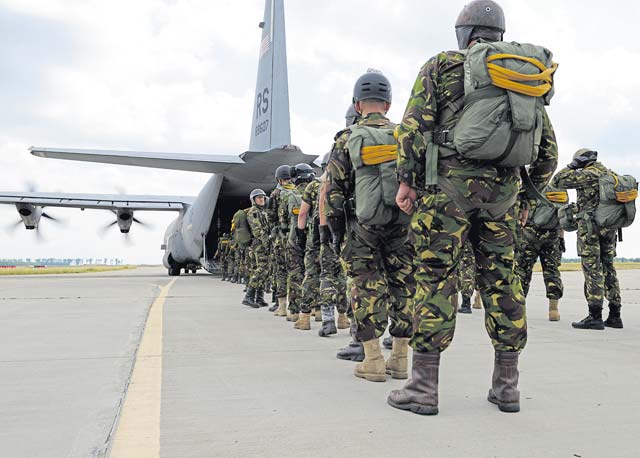
OTOPENI AIR BASE, Romania — Spirits were high among the participants of exercise Carpathian Summer as the first week came to a close Aug. 20 at Otopeni Air Base, Romania.
The exercise was designed to increase readiness and interoperability between the U.S. Air Force and Romanian air force. This was not the first time the allies have trained together, and they showed the progress prior exercises had produced.
In previous exercises with the 37th Airlift Squadron, Romanian pilots aided the U.S. pilots by providing intelligence about the area and the weather they would be flying in for planning purposes. For Carpathian Summer, the Romanian pilots flew alongside their partners in formations made up of 86th Airlift Wing C-130J Super Hercules and Romanian air force C-27J Spartan aircraft.
“It’s not only a matter of how you plan or execute a mission,” said Romanian air force Lt. Col. Emil Tecuceanu, 902nd Transport and Reconnaissance Squadron commander and Carpathian Summer director. “Today, we are flying in a peaceful environment. Tomorrow we could fight together, and we have to know each other’s techniques in order to be successful in the mission. This is the main objective of such exercises.”
The first week of the two-weeklong off-station training exercise, though suffering from minor setbacks due to weather, produced favorable results as pilots, loadmasters, maintenance personnel and other supporting members conducted training which increased their proficiency also allowing them a view of the Romanian forces’ operations.
“It’s been fantastic,” said Capt. Lindsey Kinsinger, Carpathian Summer mission commander. “The Romanians are extremely helpful. They have been supporting all of our requests, and they’re always here to learn from us and give us feedback we need to improve our own training.”
Approximately 80 personnel and three C-130Js spent the first week working on a multitude of training events.
U.S. Air Force pilots conducted low-level day and night flying operations, dropping both cargo and personnel. Thus, loadmasters were able to complete training involving loading and dropping airborne deliveries that allows them to support real-world contingencies. Romanian paratroopers also practiced both freefall and static line airborne operations alongside their U.S. counterparts, further increasing their infiltration capabilities.
The 37th AS swapped out personnel on Aug. 21 to allow for more individuals to experience working alongside their NATO allies. With the kinks ironed out during the first week, U.S. personnel and their Romanian counterparts had the opportunity to get even more value for the remainder of the exercise.
“My favorite part is when I see my guys and all the squadrons involved flying and executing missions,” Tecuceanu said. “This is the most exciting part of an exercise, as a squadron commander, when you see your guys accomplishing the mission together with your partners.”
Tecuceanu said he looks forward to how the two forces will evolve while training and conducting missions together in the future.


